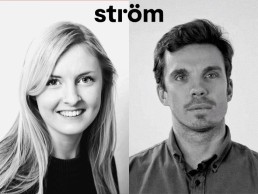
Designers Mind: An Interview with Ström
As part of its ongoing mission to spread the word about mental health and wellbeing practices, Designers Mind is conducting a series of interviews with design studios to find out more about what they’re doing to improve the wellbeing of their teams. In the first interview, Designers Mind speak to Ström, a lighting design consultancy co-founded by Anna Sandgren and Emilio Hernandez.
Ström’s mission is to create timeless, lasting lighting schemes with restrained design intervention and minimal burden on the planet through responsible sourcing. With more than 15 years of designing and specifying lighting for spaces, human impact has always been at the forefront of what they do.
Designers Mind: What does wellbeing mean to you in relation to your work? Why is it important?
Ström: It absolutely shouldn’t be a ‘Bolt on’ or seen as a company perk, it needs to be woven into your daily approach to things. Therefore building a strong company culture where the individual feels trusted and comfortable communicating and setting their own boundaries around their own mental health and wellbeing is important. This is not an easy task but we think it’s essential.
What are some of the wellbeing practices that you incorporate into your days?
We avoid talking about work after and before certain times of day and as we work and live together it’s really important that we can create that boundary without feeling stressed. We also try to enjoy the little victories, flexibility and experiences that working for yourself enables as well as things like taking the time to cook a healthy lunch and guilt-free outdoor exercise when there is a break in the weather.
Are there any changes you’d like to make to the way you work now in your own company compared with previous roles and pre-Covid? And if so, why are you making them?
A lot of the value we add as designers comes from creative thinking which does not always manifest itself as a stack of drawings or documents. So allowing time and freeing up space for creative thinking has been a big priority for us.
Our goal is to grow organically over time and to take on projects and collaborate with people that align with our own company values. As we’re a small business we cannot afford ‘burnout’ – for a lot of design companies ‘burnout’ is seen as par for the course as it’s been part of the industry culture for such a long time. This is troubling and why we think the work of Designers Mind is so important.
Would you consider implementing policies such as a ‘no meeting day’ or working core hours with flexibility?
Any tool that encourages people to take time away from things that might cause burnout is worth considering. However as wellbeing is not ‘one size fits all’ it should always be seen through the lens of the individual. In the past we have tried implementing ‘no deadlines’ or ‘no meetings’ on certain days, however we saw there was extra pressure or anxiety felt by some team members as a result.
This doesn’t mean it couldn’t work but in our experience it would be better to define boundaries for individuals and tailor the policy accordingly.
What advice do you have for other studios looking to introduce more wellbeing practices into their work too?
Again we feel wellbeing could best be seen as an employee right and part of company culture (as much as a weekend or a lunch break). If it’s seen as a company perk it becomes complex as there isn’t a one size fits all activity to suit people’s mental health needs.
The danger of it being a perk is that the employer feels that they have provided a service (i.e. gym, yoga, meditation) and the onus is now on the employee to perform as normal. If the perk doesn’t suit the employee then they will feel more anxious and the employer will feel frustrated that their team is not satisfied.
Perhaps try to understand what people find important outside of work (family, sport, travel, down time) and when they do their best work during the day and support them to balance those two within the confines of the job role. This is hard as it puts an additional pressure and demand on the senior staff to monitor this. It’s in the nature of a lot of designers to give a lot of themselves, so it’s fair for the job to try to respect that.
Read the full interview on the Designers Mind website here.



